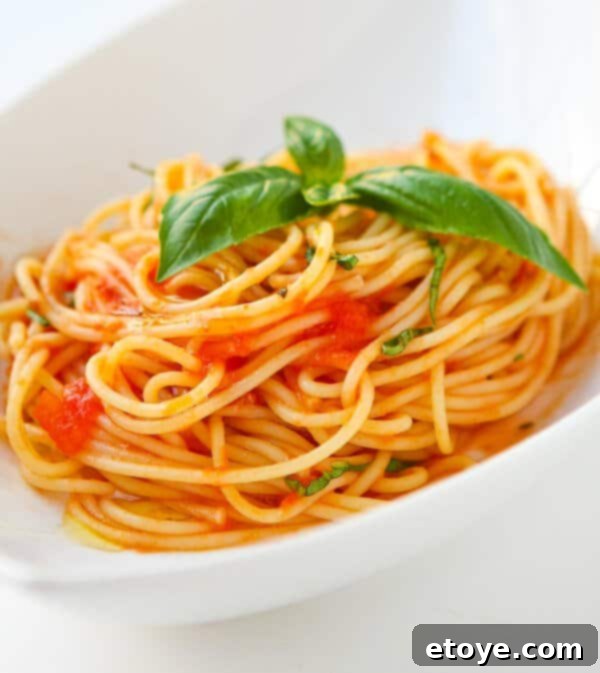In the culinary world, some dishes achieve legendary status, captivating palates and inspiring home cooks to replicate their magic. Among these, Scarpetta’s Spaghetti with Tomato and Basil stands out as an icon. Created by the acclaimed Chef Scott Conant, this deceptively simple pasta dish from Scarpetta Restaurant in New York City has earned rave reviews and a dedicated following, despite its seemingly modest presentation and a price tag that often raises eyebrows. This isn’t just a plate of pasta; it’s an experience, a testament to the power of quality ingredients and precise technique.
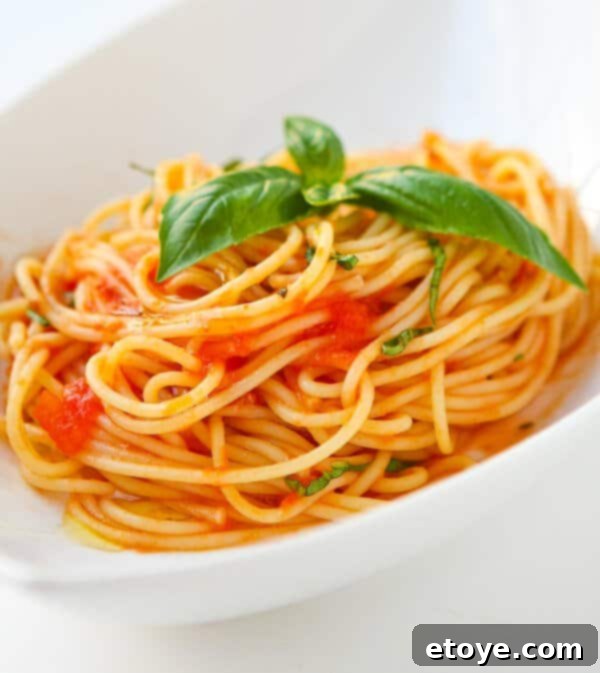
Scarpetta in New York City, a name synonymous with sophisticated Italian dining, is particularly renowned for this very dish: its Spaghetti with Tomato and Basil. Guests happily pay a premium, often around $24 per serving, for what might appear to be a straightforward pasta dish. But this isn’t the overflowing, family-style portion you might expect from a neighborhood Italian trattoria. Scarpetta serves a delicately plated portion, showcasing the dish’s elegance and focus on intense flavor over sheer volume. Some might even quip that it takes just a few twirls of the fork to finish, yet its impact is profound and memorable.
The allure of this spaghetti isn’t just about its reputation; it’s about the deep, satisfying flavors that emerge from its elegant simplicity. Countless food critics and diners have waxed poetic about it, and the internet is awash with various attempts to recreate Chef Conant’s masterpiece. Driven by the desire for authenticity and the conflicting variations found online, we sought the genuine recipe directly from the source. The secret, as it turns out, is precisely that: a commitment to simplicity, quality, and meticulous preparation.
Recreating a world-class restaurant dish at home can seem daunting, but Scarpetta’s Spaghetti proves that gourmet cooking doesn’t always require an extensive list of exotic ingredients or complex techniques. Instead, it emphasizes understanding each component and allowing its natural flavors to shine. This guide will empower you to bring the essence of Scarpetta’s celebrated pasta right into your kitchen, transforming humble tomatoes, basil, garlic, and spaghetti into an extraordinary meal.
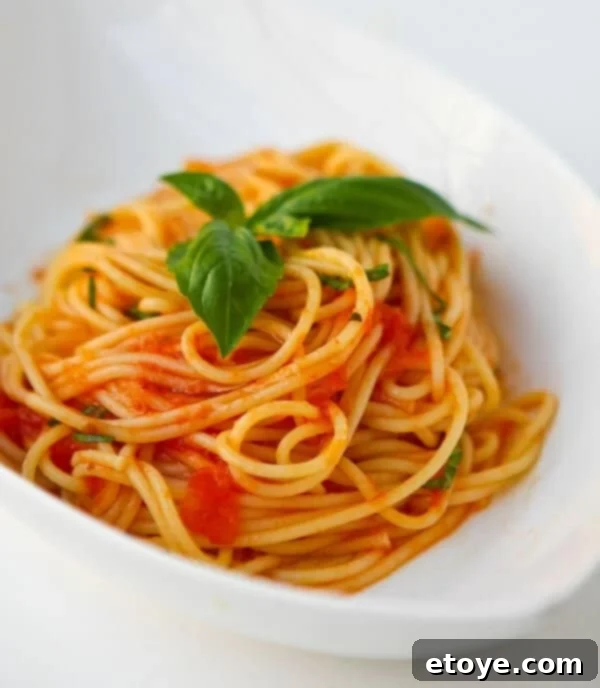
Mastering Scarpetta’s Spaghetti: A Culinary Journey
At the heart of Scarpetta’s signature spaghetti are two essential components: a vibrant, intensely flavored tomato sauce and an aromatic garlic-basil infused olive oil. Both are meticulously prepared, contributing layers of fresh, herbaceous, and savory notes that elevate the entire dish. This recipe guides you through each step, ensuring you achieve the depth of flavor that makes Chef Conant’s creation so iconic.
Crafting the Perfect Tomato Sauce: The Foundation of Flavor
The journey to the perfect Scarpetta spaghetti begins with the tomatoes. Chef Scott Conant is known for his insistence on ripe, high-quality tomatoes, favoring plum varieties for their dense flesh and lower water content. The most crucial step for a smooth, intensely flavored sauce is preparing these tomatoes correctly. Start by selecting the freshest organic tomatoes available, whether they are plum tomatoes like Roma or San Marzano, or other ripe varieties that catch your eye.
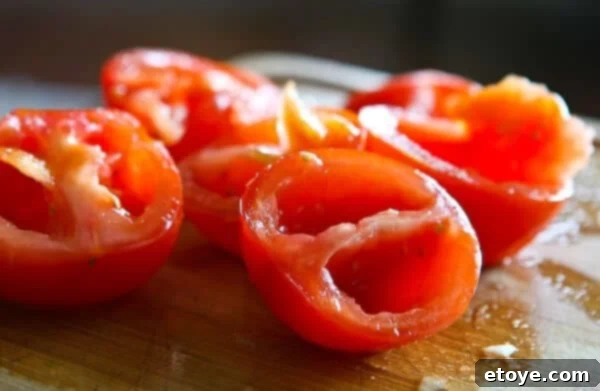
Once selected, the tomatoes need to be peeled and deseeded. While peeling can be done by blanching, Conant’s method suggests a gentle sawing motion with a sharp vegetable peeler, which can be surprisingly effective for firm, ripe tomatoes. The deseding process is equally important: cut each tomato in half and carefully scoop out the watery seeds with your fingers. This step prevents the sauce from becoming diluted and watery, ensuring a concentrated, pure tomato flavor. This dedication to removing excess moisture is key to achieving a deeply flavorful and thick sauce that clings beautifully to the pasta.
After preparing the fresh tomatoes, you’ll combine them with high-quality canned San Marzano tomatoes. This blend offers the best of both worlds: the brightness of fresh tomatoes and the consistent ripeness and robust flavor of canned varieties, which are often picked at their peak. Cook the tomatoes with extra virgin olive oil and a hint of crushed red chili pepper flakes, allowing them to soften before crushing them with a potato masher. This slow cooking and gentle crushing extract maximum flavor, resulting in a rich, sweet, and slightly tart sauce that is the true soul of the dish.
The Aromatic Essence: Garlic-Basil Infused Olive Oil
The second pillar of Scarpetta’s spaghetti is its exquisite Garlic-Basil Oil. This infused oil adds a fragrant, herbaceous, and subtly spicy dimension that rounds out the dish perfectly. The beauty of this oil lies in its simplicity and the slow infusion process that extracts the maximum flavor from each ingredient.

The ingredients are straightforward: fresh basil, thinly sliced garlic, and a pinch of chili flakes, all gently heated in good quality extra virgin olive oil. The infusion process requires patience and a low, consistent heat. Allowing the ingredients to steep for at least 20 minutes—10 minutes on very low heat, followed by 10 minutes off the heat—permits the flavors to meld and infuse deeply into the oil. The longer the steeping, the more pronounced and complex the oil’s aroma and taste will be.
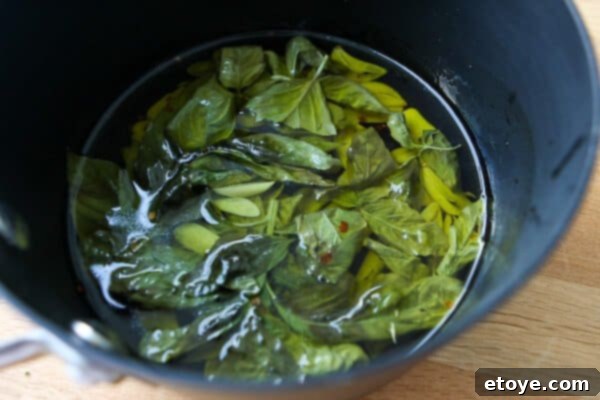

Once infused, the oil should be strained to remove the solids. While you won’t use all of it for a single serving of spaghetti, the leftover oil is a culinary treasure. It can be refrigerated for several days and used to enhance countless other dishes, from drizzling over vegetables to flavoring soups and salads. However, a crucial safety note: garlic infused in oil should never be stored at room temperature, as it poses a risk of botulism. Always refrigerate immediately and use within a few days to ensure safety.
The Final Touch: Al Dente Pasta and Harmonious Blending
With the sauce simmering and the oil infusing, attention turns to the spaghetti itself. The choice of pasta matters; opt for a high-quality dry spaghetti or, for the truly ambitious, homemade pasta. The cooking method is equally critical: boil the pasta in amply salted water until it is just shy of al dente. This slight undercooking allows the pasta to finish cooking in the sauce, absorbing its flavors and creating a perfectly integrated dish.
After draining the pasta, reserving a little of the starchy cooking water, it’s immediately added to the tomato sauce. Over medium-high heat, the pasta and sauce are vigorously tossed together. This dynamic movement, often involving wooden spoons and even shaking the pan, helps the pasta absorb the sauce and ensures any separated oil in the sauce becomes cohesive. If the sauce appears too thick, a splash of the reserved pasta water can loosen it to the ideal consistency, creating a silky, emulsified coating on each strand.
The grand finale involves removing the pan from the heat and tossing in cold unsalted butter, fresh basil chiffonade, and freshly grated Parmigiano-Reggiano cheese. The cold butter emulsifies beautifully with the warm sauce, adding a luxurious richness, while the fresh basil contributes its vibrant aroma. Finally, just before serving, each plate of spaghetti is graced with a delicate drizzle of the homemade Garlic-Basil Oil. This final touch isn’t just for flavor; it adds an enticing sheen and another layer of aromatic complexity, completing the dish.

Why This Recipe Works: The Philosophy of Fine Dining at Home
The enduring popularity of Scarpetta’s Spaghetti lies in its profound understanding of flavor. Chef Conant’s philosophy champions simplicity, allowing premium ingredients to speak for themselves. This isn’t a sauce-heavy dish where the pasta is drowned; instead, it’s a harmonious balance where a light, vibrant sauce and fragrant oil coat each strand, delivering intense flavor in every bite. It’s a testament to Italian culinary wisdom: when ingredients are excellent, less is truly more.
By following this authentic Scarpetta’s Spaghetti recipe, you’re not just cooking a meal; you’re engaging in a culinary art form that prioritizes quality, technique, and a deep respect for natural flavors. This dish is perfect for a weeknight dinner when you crave something special, or for impressing guests with a sophisticated yet approachable meal. Prepare to be amazed at how a few simple ingredients can create such an unforgettable gastronomic experience.
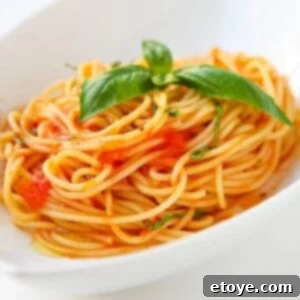
Scarpetta’s Spaghetti Recipe: Fresh Tomato Sauce and Garlic Basil Oil
Jaden
Chef Conant famously prefers 20 ripe plum tomatoes, avoiding canned. However, our adaptation includes a blend of both fresh and high-quality canned San Marzano tomatoes. This approach often yields a more consistently flavorful sauce, as canned tomatoes are picked at peak ripeness, ensuring a perfect balance of tartness and sweetness. Feel free to use all fresh, all canned, or this recommended combination based on availability and desired intensity.
Do not expect a heavy, sauce-laden pasta. Conant’s recipe champions a light touch; the barely-there sauce, combined with the potent basil-garlic oil, delivers an explosion of intense, pure flavors without overwhelming the pasta.
This recipe yields approximately 1 pound of dried pasta, generously serving 6-8 people. Keep in mind that at Scarpetta, a single serving is typically half this amount, emphasizing the dish’s richness and the premium experience.
Pin Recipe
Ingredients
- 4 ripe organic tomatoes preferably plum tomatoes (Roma or San Marzano)
- 12 ounces San Marzano or organic whole tomatoes canned, crushed by hand
- 2 tablespoons extra virgin olive oil
- 1/4 teaspoon crushed red chili pepper flakes
- Kosher salt and freshly ground black pepper to taste, adjust carefully
- 2 tablespoons unsalted butter cold, cut into small pieces
- 1/2 cup freshly grated Parmigiano-Reggiano cheese plus more for serving
- 8 fresh basil leaves well washed and dried, stacked, rolled into a cylinder, and sliced thinly crosswise into a chiffonade
- 1 pound spaghetti either high-quality dry pasta or fresh homemade
For the Basil-Garlic Oil:
- 1/4 cup extra virgin olive oil good quality
- 8 whole cloves garlic thinly sliced
- 10 whole fresh basil leaves
- 1/4 teaspoon crushed red chili pepper flakes
Instructions
- To prepare the fresh tomatoes: Use a sharp vegetable peeler and a gentle, back-and-forth sawing motion to peel the tomato skin. The motion should be very slight, moving quickly along the tomato. Once peeled, cut the tomatoes in half and use your fingers to flick out the seeds. This prevents a watery sauce and concentrates the flavor.
- Prepare the tomato sauce: Heat 2 tablespoons of extra virgin olive oil in a wide pan over medium-high heat until it shimmers. Add the peeled and deseeded fresh tomatoes along with the canned tomatoes (crushed by hand), and the crushed red pepper flakes. Season lightly with kosher salt and freshly ground black pepper. (It’s always best to start with a light hand, as salt intensifies as the sauce reduces.) Cook the tomatoes for a few minutes until they begin to soften.
Using a potato masher, crush the tomatoes directly in the pan. Continue cooking, stirring occasionally, until the tomatoes are very tender and the sauce has significantly thickened, which typically takes 20 to 25 minutes.
- Adjust seasoning: Taste the tomato sauce and season again lightly with salt, remembering that the pasta water will also be salty. If your fresh tomatoes were not perfectly ripe and the sauce tastes too tart, you can balance it with about 1/2 teaspoon of sugar.
Make ahead tip: This sauce, yielding approximately 2-3 cups, can be prepared in advance. Refrigerate it for up to two days or freeze it for longer storage.
- Prepare the basil-garlic oil: While the tomato sauce is simmering, begin making the infused oil. In a small saucepan, combine 1/4 cup extra virgin olive oil, sliced garlic cloves, whole basil leaves, and pepper flakes. Heat over very low heat, just enough to gently warm the ingredients and allow them to slowly release their flavors without frying. Continue heating until the garlic is lightly browned. Turn off the heat and let the oil steep for at least 10 minutes (the longer it sits, the more infused the flavor). Strain the oil, discarding the solids. Store any unused oil in the refrigerator for a few days (do not store garlic in oil at room temperature due to botulism risk).
- Cook the spaghetti: Bring a large pot of generously salted water to a rolling boil. Add the spaghetti and cook until it is just shy of al dente – meaning it still has a firm bite. Drain the pasta, making sure to reserve about 1/2 cup of the starchy pasta cooking water. This water is invaluable for adjusting the sauce consistency.
- Combine pasta and sauce: Add the partially cooked spaghetti directly to the pan with the tomato sauce. Cook over medium-high heat, vigorously tossing the pasta and sauce together. Use a pair of wooden spoons and plenty of exaggerated movement, even shaking the pan, until the pasta is perfectly al dente and the sauce appears cohesive and well-emulsified (if any oil had separated, it should now integrate). If the sauce seems too thick or dry, gradually add a little of the reserved pasta cooking liquid to achieve your desired consistency.
- Finish and serve: Remove the pan from the heat. Add the cold unsalted butter pieces, fresh basil chiffonade, and freshly grated Parmigiano-Reggiano cheese to the pasta. Toss everything together in the same vigorous manner until the butter has melted and the pasta takes on a beautiful orange hue, coated evenly. Plate the spaghetti immediately. Before serving, drizzle each portion with a small amount of the prepared basil-garlic oil. You might not use all the oil, but the fresh aroma and flavor it imparts are crucial to the Scarpetta experience. Serve with extra grated Parmigiano-Reggiano on the side.
